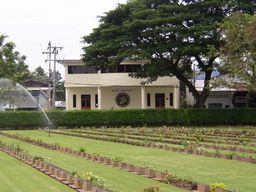
Most of these men died from malnutrition, illness and disease and general ill-treatment at the hands of Japanese and Korean guards. The construction of the railway over some 14 months cost the lives of approximately 12,400 POWs out of 61,000 who worked on the railway – 6,318 British, 2,490 Dutch and 2,815 Australian. Ronsi, Burma, c.1943: Burial service for a POW on the Burma–Thaliand railway. POWs and Asian labourers utilising mainly primitive equipment and hand tools accomplished all of this work. Japanese engineers estimated that in the building of the approximately 420 kilometre line, 4,000,000 cubic metres of earthwork was constructed, 3,000,000 cubic metres of rock was shifted and 14 kilometres of bridgework was erected. Ronsi, Burma, c.1943: POWs building an embankment on the Burma–Thailand railway. Of the approximately 13,000 Japanese engineers and guards who worked on the railway some 1,000 died. The two lines met at Konkoita, Thailand, on 16 October 1943. Japanese engineers were responsible for the building of the railway and construction commenced from the Burmese end in September 1942 and from the Thailand end in October. Ronsi was approximately 60 kilometres from the end of the Burma–Thailand railway at Thanbyuzayat in Burma. Ronsi, Burma, c.1943: Japanese soldiers praying for the dead of the Imperial Japanese Army.

To build the railway the Japanese used approximately 61,000 Allied POWs – 31,000 British, 18,000 Dutch, which included Eurasian and Indonesians, and 13,000 Australians – and over 250,000 Asian labourers. The railway was constructed simultaneously from the Thai and Burmese ends between Thanbyuzayat in Burma and Bampong in Thailand. Some of these men are clearly Australian soldiers and most likely members of those forces – A Force, Williams Force, Black Force and Group 5 – brought from Singapore or Java via Singapore to work on the northern end of the railway. Ronsi, Burma, c.1943: Allied POWs laying track on the Burma–Thailand railway. The trains travelled very slowly so an average journey took 4–5 uncomfortable days and nights. Thousands of men were taken north in this way packed 30–40 men per carriage. This POW resistance to the Japanese became known as “the Selerang Barracks incident”.īurma–Thailand Railway, c.1945: An example of the kind of railway wagon used to transport British and Australian POWs from Singapore to Thailand in work parties to build the Burma–Thailand railway during 19. A Japanese order was forthcoming and on 5 September the POWs were allowed back to their former areas. Despite this the POWs refused to sign the non-escape agreement unless the Japanese authorities actually ordered them to do so. There were only two water taps and rations were cut by a third. On 2 September 1942 four POWs, including two Australians, were shot for an escape attempt and after this over 15,400 POWs, 1,900 of them Australians, were concentrated at Selerang Barracks into an area of little more than three hectares. Hospital area, Selerang Barracks, Singapore Island, September 1942: The overcrowding visible here resulted from the Japanese forcing excess numbers of prisoners of war into the barracks after their refusal to sign an undertaking not to attempt to escape. War for the Empire | Japanese Advance | Australia under Attack | Japanese Retreat | Australians in Captivity | Japanese in Captivity | Victory and Defeat The Hellfire Pass Interpretive Centre and Memorial Walking Trail is being reopened today at the site, for people paying tribute to the fallen and those curious about the railway’s history.Explanatory essay: Australia and Japan at War, 1941-1946 After the war it became a place of pilgrimage. But they were not afraid to overwork this labour force to build what they needed to make war.Seventy five years ago this year Japanese soldiers pushed about 700 Allied prisoners, including many Australians, to their deaths building a small section of the Thai-Burma Railway through what became known as the Hellfire Pass at Konyu in Thailand. While the Japanese may have considered prisoners of war worthless as human beings they were at least useful as forced labour. There was a strong Japanese military culture that a soldier’s duty was to either die fighting or commit suicide rather than be captured. These men were considered as lacking dignity for being captured alive. They were particularly hard on enemy soldiers they had taken prisoner.

The Japanese army were noted for their cruelty during World War II.

Japanese worked 700 to death at Hellfire Pass


 0 kommentar(er)
0 kommentar(er)
